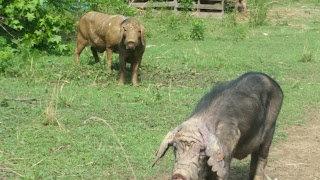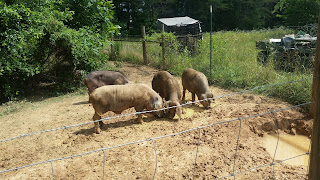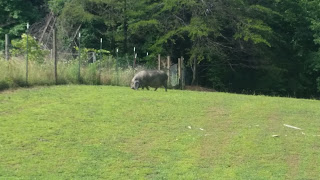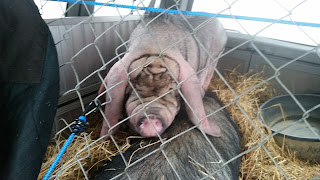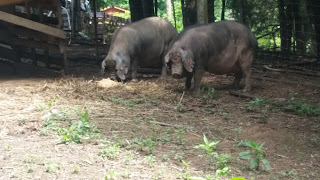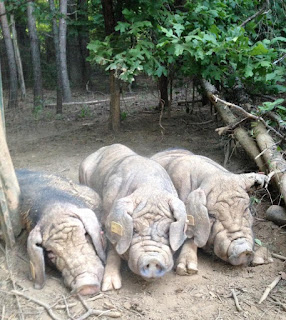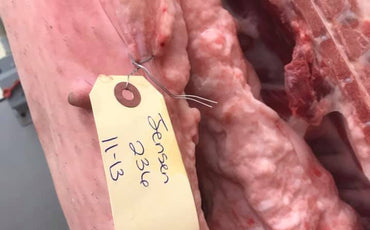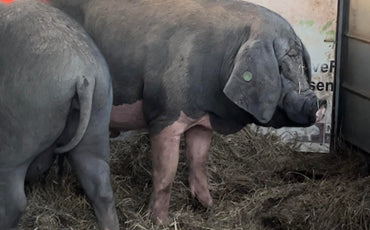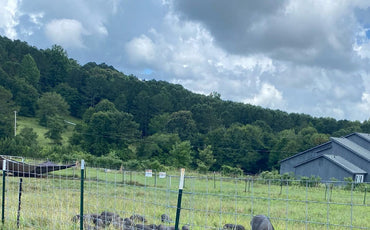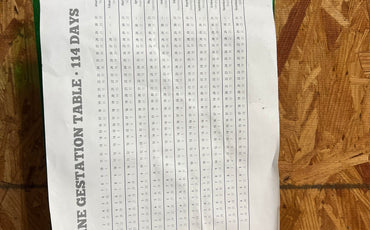This is the story of how the last Meishan Pig genetics were saved
I was just looking for one more boar…An unusual detective story
It’s her fault…That’s my story and I am sticking to it.
Where did these strange looking pigs come from?
I look out on the fields of our farm and I see these rather odd pigs quietly grazing and sleeping. And everywhere I look it seems like I see them. This is way more pigs than any plan I had originally for our little farm. It’s my wife’s fault.
My wife found them first.
You see about 6 years ago (2013)she shows me this webpage on Chinese Meishan pigs. Now understand we had pigs at the time (too many to her thinking/liking). I was in the middle of building an American Guinea Hog herd that I had traveled to 7 different states to assemble. It was a nice little hog but my wife was concerned about their impact on our land. Because regardless of what some might say they do root(though much less than traditional commercial breeds).
We had tried several heritage breeds already
We had tried Gloucester Old Spots. But after the piglets, we brought in confirmed beyond a shadow of a doubt that there were no secret deposits of oil on the property(as deep as they dug we would have hit a gusher by now) they moved quickly to the freezer. We dabbled with some Kune Kune. And we found whatever their differences to AGH a personality devoid of rooting wasn’t one of them.
Too good to be true?
So here comes my wife with this info on a wrinkly faced hyper-productive pig from China. So I began to investigate. For about 8 months it was the usual web pages and Facebook groups. And the more I looked the more intrigued I was. The Facebook groups would have scared most folks off, however. At the time there was a running feud between two or three breeders. And I don’t mean your usual FB spat this was more like a lifetime movie script with pages and the “truth about” pages. It got pretty ugly.
But the more I read about the pig the more I saw the same things I liked about my AGH but with a larger size, faster growth, larger litters and if you were to believe the write-ups even a more docile nature. So I contacted the two most polarized breeders to discuss the breed. I talked to the Hatfields and then I talked to the McCoys.
The first step.
And another year passed while my own AGH herd was growing and people seemed to support our concepts of breeding for traits to benefit a smallholder (stronger hams and shoulder and faster growth rates). A customer would come from here and a customer would come from there and the next thing I knew we had our pigs in herds in twelve different states. But still, we had hit what I call the “glass ceiling” that plagues AGH and KK. That is the limitations of the pig ( small size, very slow growth, smaller litters, and a limited meat outlet) meant it had risen about as far as it could on my farm. It could pay for its feed and a little more but it had no real end game as a meat animal for individual customers or restaurants.
Just as advertised
So in December of 2015, I acquired a boar and two unrelated sister gilts from the breeder that I had the highest confidence in at the time and we were off. We fell in love with the pigs. Original plans to cross them with the AGH were scrapped as this was just a better pig for us. It had a lower pasture environmental impact, it was quiet bordering on silent and everything written about how docile it was absolutely true. This was a GREAT pig. And even my wife loved them.
The search for genetic diversity
But I needed at least another boar and another gilt would be great. Our farm model was always about enough genetic diversity to sell breeding pairs. So the search began in earnest. I found another breeder but honestly, nobody seemed to know or was willing to tell where their stock came from. I had learned from my AGH that you could end up with liter mates even if you got pigs from two wildly separated states. So I sent the e-mails out. I sent e-mails to USDA Scientists. Then I sent e-mails to Iowa State. Finally, I sent e-mails to Illinois. Basically, if you were remotely associated with the original study you got an e-mail from me. The responses? It was the sounds of crickets, nothing, nada, zilch.
One kind soul
The Illinois opportunity
Still looking for one more boar
The final negotiation
Are you all in?
When I told my wife I was buying five boars sight unseen (It violates USDA policy to distribute pictures of stock in the USMARC Facility) she looked at me like I was a madman. That meant we would have six Meishan boars and six Meishan sows on the property along with our AGH pigs. But when we talked about it we realized we might be buying the last five passenger pigeons. What we didn’t take would be quite literally lost. When the swine manager at USMARC sent me the breeding records and it was apparent that these were five genetically distinct boars. And there were two unrelated and genetically distinct sows. It was the all in or all out bet at the poker table. And we decided to go all in.
All in means all five boars stay.
And by mean all in I mean all in. We could not just buy these seven hogs. We would commit to keeping them and the other Meishan Pig genetics we had collected. Because it wouldn’t have been any problem to have sold off any or all of these pigs. They are quite literally the rarest Meishan Pigs outside of China. But then once again the genetics of the breed would be scattered. And scattered into a community that didn’t have the best track record of cooperation. The genetic death spiral of the Meishan Pig might be delayed. But it couldn’t be forestalled.
Only one breed here on the farm
No, if we kept all of these pigs it would have to take a commitment. A commitment to maintain the most genetically diverse herd outside of China. A herd that could be used to supply fresh genetics to every current and future Meishan Pig owner. With that decision came other realizations. Our other pigs could not stay. We could not serve two breeds. After a year on the American Guinea Hog Association Board of Directors, I knew the breed was well on its way to recovery.
The next journey
So here we are three road trips,4,595 actual driving miles and seven travel days later. I look out on the fields of our farm and I see these rather odd pigs quietly grazing and sleeping. And everywhere I look it seems like I see them. And now you can see them here
It’s her fault. That’s my story and I am sticking to it. May the Lord bless you and yours
Rico
Postscript.
In order of contact:
- Steven Moeller Department of Animal Sciences Ohio State University
- Dr. Steven Loerch Head of the Department of Animal Sciences University of Illinois
- Jonathan Forrest Mosely Swine Herd Manager University of Illinois
- Jeffrey Valet Geneticist USDA US Meat Animal Research Center Clay Center NE.
- Dr. E John Pollak Facility Director USDA US Meat Animal Research Center Clay Center NE
- Troy McCain Swine Herd Manager USDA US Meat Animal Research Center Clay Center NE
- Gary Rohrer Swine Geneticist USDA US Meat Animal Research Center Clay Center NE
- Dr. Max Rothschild Department of Animal Sciences Iowa State University
- Harvey Blackburn Senior Animal Geneticist USDA Genetic Resource Preservation Sevice Fort Collins CO.
Whether you are a Meishan Pig Breeder or just thinking of becoming a Meishan Pig Breeder you need the latest information on the breed. Then we invite you to sign up for our Farm newsletter “Meishan Tales”. We won’t spam you or share/sell your email info and you can unsubscribe at any time


